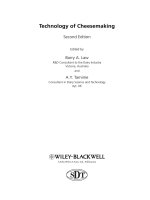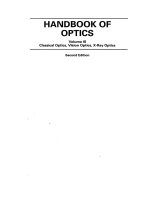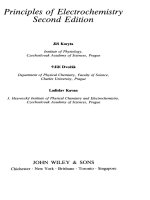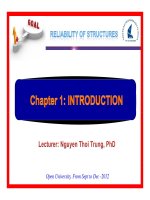Reliability of structures, second edition (1)
Bạn đang xem bản rút gọn của tài liệu. Xem và tải ngay bản đầy đủ của tài liệu tại đây (42.17 MB, 403 trang )
Reliability of
StRuctuReS
Second edition
Andrzej S. Nowak
Kevin R. Collins
Boca Raton London New York
CRC Press is an imprint of the
Taylor & Francis Group, an informa business
CRC Press
Taylor & Francis Group
6000 Broken Sound Parkway NW, Suite 300
Boca Raton, FL 33487-2742
© 2013 by Andrzej Nowak and Kevin R. Collins
CRC Press is an imprint of Taylor & Francis Group, an Informa business
No claim to original U.S. Government works
Version Date: 2012928
International Standard Book Number-13: 978-0-203-80914-3 (eBook - PDF)
This book contains information obtained from authentic and highly regarded sources. Reasonable efforts
have been made to publish reliable data and information, but the author and publisher cannot assume
responsibility for the validity of all materials or the consequences of their use. The authors and publishers
have attempted to trace the copyright holders of all material reproduced in this publication and apologize to
copyright holders if permission to publish in this form has not been obtained. If any copyright material has
not been acknowledged please write and let us know so we may rectify in any future reprint.
Except as permitted under U.S. Copyright Law, no part of this book may be reprinted, reproduced, transmitted, or utilized in any form by any electronic, mechanical, or other means, now known or hereafter invented,
including photocopying, microfilming, and recording, or in any information storage or retrieval system,
without written permission from the publishers.
For permission to photocopy or use material electronically from this work, please access www.copyright.
com ( or contact the Copyright Clearance Center, Inc. (CCC), 222 Rosewood
Drive, Danvers, MA 01923, 978-750-8400. CCC is a not-for-profit organization that provides licenses and
registration for a variety of users. For organizations that have been granted a photocopy license by the CCC,
a separate system of payment has been arranged.
Trademark Notice: Product or corporate names may be trademarks or registered trademarks, and are used
only for identification and explanation without intent to infringe.
Visit the Taylor & Francis Web site at
and the CRC Press Web site at
Contents
Preface
Acknowledgments
Authors
xi
xiii
xv
1Introduction1
1.1
1.2
1.3
1.4
1.5
Overview 1
Objectives of the book 2
Possible applications 2
Historical perspective 3
Uncertainties in the building process 4
2 Random variables7
2.1
2.2
2.3
2.4
Basic definitions 7
2.1.1 Sample space and event 7
2.1.2 Axioms of probability 9
2.1.3 Random variable 10
2.1.4 Basic functions 11
Properties of probability functions
(CDF, PDF, and PMF) 14
Parameters of a random variable 15
2.3.1 Basic parameters 15
2.3.2 Sample parameters 17
2.3.3 Standard form 17
Common random variables 18
2.4.1 Uniform random variable 18
2.4.2 Normal random variable 19
2.4.3 Lognormal random variable 25
2.4.4 Gamma distribution 27
v
vi Contents
2.4.5
Extreme Type I (Gumbel distribution,
Fisher–Tippett Type I) 28
2.4.6 Extreme Type II 29
2.4.7 Extreme Type III (Weibull distribution) 30
2.4.8 Poisson distribution 31
2.5 Probability paper 33
2.6 Interpretation of test data using statistics 41
2.7 Conditional probability 47
2.8 Random vectors 48
2.9 Correlation 54
2.9.1 Basic definitions 54
2.9.2 Statistical estimate of the
correlation coefficient 57
2.10 Bayesian updating 57
2.10.1 Bayes’ Theorem 57
2.10.2 Applications of Bayes’ Theorem 58
2.10.3 Continuous case 61
Problems 62
3 Functions of random variables65
3.1
3.2
3.3
3.4
3.5
Linear functions of random variables 65
Linear functions of normal variables 67
Product of lognormal random variables 70
Nonlinear function of random variables 73
Central limit theorem 76
3.5.1 Sum of random variables 76
3.5.2 Product of random variables 76
Problems 77
4 Simulation techniques81
4.1
Monte Carlo methods 81
4.1.1 Basic concept 81
4.1.2 Generation of uniformly
distributed random numbers 84
4.1.3 Generation of standard
normal random numbers 85
4.1.4 Generation of normal random numbers 86
4.1.5 Generation of lognormal random numbers 90
4.1.6 General procedure for generating random
numbers from an arbitrary distribution 91
Contents vii
4.1.7
4.1.8
4.2
4.3
Accuracy of probability estimates 91
Simulation of correlated
normal random variables 94
Latin hypercube sampling 97
Rosenblueth’s 2K + 1 point estimate method 100
Problems 104
5 Structural safety analysis107
5.1
5.2
5.3
5.4
5.5
Limit states 107
5.1.1 Definition of failure 107
5.1.2 Limit state functions (performance functions) 111
Fundamental case 113
5.2.1 Probability of failure 113
5.2.2 Space of state variables 115
Reliability index 116
5.3.1 Reduced variables 116
5.3.2 General definition of the reliability index 117
5.3.3 First-order, second-moment reliability index 119
5.3.3.1 Linear limit state functions 119
5.3.3.2 Nonlinear limit state functions 121
5.3.4 Comments on the first-order, secondmoment mean value index 124
5.3.5 Hasofer–Lind reliability index 126
Rackwitz–Fiessler procedure 141
5.4.1 Modified matrix procedure 141
5.4.2 Graphical procedure 152
5.4.3 Correlated random variables 155
Reliability analysis using simulation 162
Problems 172
6 Structural load models177
6.1
6.2
6.3
6.4
6.5
Types of load 177
General load models 177
Dead load 180
Live load in buildings 181
6.4.1 Design (nominal) live load 181
6.4.2 Sustained (arbitrary point-in-time) live load 183
6.4.3 Transient live load 183
6.4.4 Maximum live load 183
Live load for bridges 185
viii Contents
6.6
6.7
Environmental loads 190
6.6.1 Wind load 190
6.6.2 Ice load 192
6.6.3 Snow load 193
6.6.4 Earthquake 194
Load combinations 197
6.7.1 Time variation 197
6.7.2 Borges model for load combination 198
6.7.3 Turkstra’s rule 200
6.7.4 Load coincidence method 204
6.7.4.1 Poisson pulse processes 204
6.7.4.2 Combinations of Poisson
pulse processes 205
Problems 209
7 Models of resistance211
7.1
7.2
7.3
7.4
7.5
Parameters of resistance 211
Steel components 213
7.2.1 Hot-rolled steel beams (noncomposite behavior) 213
7.2.2 Composite steel girders 217
7.2.3 Shear capacity of steel beams 220
7.2.4 Steel columns 220
7.2.5 Cold-formed members 221
Aluminum structures 222
Reinforced and prestressed concrete components 223
7.4.1 Concrete elements in buildings 223
7.4.2 Concrete elements in bridges 227
7.4.2.1 Moment capacity 227
7.4.2.2 Shear capacity 233
7.4.3 Resistance of components with
high- strength prestressing bars 237
Wood components 239
7.5.1 Basic strength of material 239
7.5.2 Flatwise use factor 241
7.5.3 Resistance of structural components 243
8 Design codes247
8.1 Overview 247
8.2 Role of a code in the building process 248
8.3 Code levels 251
Contents ix
8.4
8.5
8.6
8.7
8.8
Code development procedure 252
8.4.1 Scope of the code 253
8.4.2 Code objective 254
8.4.3 Demand function and frequency of demand 256
8.4.4 Closeness to the target (space metric) 257
8.4.5 Code format 259
Calibration of partial safety factors for a Level I code 261
Development of a bridge design code 278
8.6.1 Scope 278
8.6.2 Objectives 278
8.6.3 Frequency of demand 280
8.6.4 Target reliability level 280
8.6.5 Load and resistance factors 283
Example of the code calibration—ACI 318 288
8.7.1 Scope 288
8.7.2 Calibration procedure 288
8.7.3 Reliability analysis 289
8.7.4 Target reliability index 290
8.7.5 Results of reliability analysis 291
Concluding remarks 293
Problems 293
9 System reliability297
9.1
9.2
9.3
9.4
Elements and systems 297
Series and parallel systems 298
9.2.1 Series systems 299
9.2.2 Parallel systems 304
9.2.2.1 Parallel systems with perfectly
ductile elements 305
9.2.2.2 Parallel systems with brittle elements 307
9.2.3 Hybrid (combined) systems 308
Reliability bounds for structural systems 311
9.3.1 Boolean variables 311
9.3.2 Series systems with positive correlation 313
9.3.3 Parallel systems with positive correlation 315
9.3.4 Ditlevsen bounds for a series system 316
Systems with equally correlated elements 317
9.4.1 Series systems with equally correlated elements 317
9.4.2 Parallel systems with equally
correlated ductile elements 322
x Contents
9.5
Systems with unequally correlated elements 328
9.5.1 Parallel system with ductile elements 328
9.5.2 Series system 332
9.6 Summary 334
Problems 335
10 Uncertainties in the building process339
10.1 Introduction 339
10.1.1 Human error 339
10.1.2 Categories of uncertainty 340
10.1.3 Theoretical and actual failure rates 341
10.1.4 Previous research 342
10.2 Classification of errors 343
10.3 Error surveys 346
10.4 Approach to errors 349
10.5 Sensitivity analysis 352
10.5.1 Procedure 352
10.5.2 Bridge slab 352
10.5.3 Beam-to-column connection 354
10.5.4 Timber bridge deck 355
10.5.5 Partially rigid frame structure 356
10.5.6 Rigid frame structure 357
10.5.7 Noncomposite steel bridge girder 357
10.5.8 Composite steel bridge girder 358
10.5.9 Reinforced concrete T-beam 359
10.5.10Prestressed concrete bridge girder 360
10.5.11Composite steel bridge system 360
10.6 Other approaches 360
10.7 Conclusions 363
Appendix A: Acronyms365
Appendix B: Values of the CDF Φ(z) for the standard
normal probability distribution367
Appendix C: Values of the gamma function
373
Bibliography
375
Preface
The objective of this book is to provide the reader with a practical tool
for reliability analysis of structures. The presented material is intended to
serve as a textbook for a one-semester course for undergraduate seniors
or graduate students. The material is presented assuming that the reader
has some background in structural engineering and structural mechanics.
Previous exposure to probability and statistics is helpful but not required;
the most important aspects of probability and statistics are reviewed early
in the text.
Many of the available books on reliability are written for researchers,
and these texts often approach the subject from a very mathematical and
theoretical perspective. The focus of this book is on practical applications
of structural reliability theory. The book does not provide detailed mathematical proofs of the underlying theory; instead, the book presents the
basic concepts, interpretations, and equations and then explains to the
reader how to use them. The book should be useful for both students and
practicing structural engineers and hopefully will broaden their perspective by considering reliability as another important dimension of structural
design. In particular, the presented methodology is applicable in the development of design codes, development of more reliable designs, optimization, and rational evaluation of existing structures.
The text is divided into 10 chapters with regard to topics.
Chapter 1 provides an introduction to structural reliability analysis. The
discussion deals with the objectives of the study of reliability of structures
and the sources of uncertainty inherent in structural design.
Chapter 2 provides a brief review of the theory of probability and statistics. The emphasis is placed on the definitions and formulas that are needed
for derivation of the reliability analysis procedures. The material covers
the definition of a random variable and its parameters such as the mean,
median, standard deviation, coefficient of variation, cumulative distribution function, probability density function, and probability mass function.
The probability distributions commonly used in structural reliability applications are reviewed; these include the normal; lognormal; extreme Type I,
xi
xii Preface
II, and III; uniform; Poisson; and gamma distributions. A brief discussion
of Bayesian methods is also included.
In Chapter 3, functions of random variables are considered. Concepts
and parameters such as covariance, coefficient of correlation, and covariance matrix are described. Formulas are derived for parameters of a function of random variables. Special cases considered in this chapter are the
sum of uncorrelated normal random variables and the product of uncorrelated lognormal random variables.
Chapter 4 presents some simulation techniques that can be used to solve
structural reliability problems. The Monte Carlo simulation technique is
the focus of this chapter. Two other methods are also discussed: the Latin
Hypercube sampling method and Rosenblueth’s point estimate method.
The concepts of limit states and limit state functions are defined in
Chapter 5. Reliability and probability of failure are considered as functions
of load and resistance. The fundamental structural reliability problem is
formulated. The reliability analysis methods are also presented in Chapter
5. The simple second-moment mean value formulas are derived. Then, the
Hasofer–Lind reliability index is defined. An iterative procedure is shown
for variables with full distributions available.
The development of a reliability-based design code is discussed in
Chapter 6. The presented material includes the basic steps for finding load
and resistance factors and a calibration procedure used in several recent
research projects.
Load models are presented in Chapter 7. The considered load components include dead load, live load for buildings and bridges, and environmental loads (such as wind, snow, and earthquake). Some techniques for
combining loads together in reliability analyses are also presented.
Resistance models are discussed in Chapter 8. Statistical parameters are
presented for steel beams, columns, tension members, and connections.
Noncomposite and composite sections are considered. For reinforced concrete members and prestressed concrete members, the parameters are given
for flexural capacity and shear. The results are based on the available test
data and simulations.
Chapter 9 deals with the important topic of system reliability. Useful
formulas are presented for a series system, a parallel system, and mixed
systems. The effect of correlation between structural components on the
reliability of a system is evaluated. The approach to system reliability analysis is demonstrated using simple practical examples.
Models of human error in structural design and construction are
reviewed in Chapter 10. The classification of errors is presented with regard
to mechanism of occurrence, cause, and consequences. Error survey results
are discussed. A strategy to deal with errors is considered. Special focus is
placed on the sensitivity analysis. Sensitivity functions are presented for
typical structural components.
Acknowledgments
Work on this book required frequent discussions and consultations with
many experts in theoretical and practical aspects of structural reliability.
Therefore, we would like to acknowledge the support and inspiration we
received over many years from our colleagues and teachers, in particular
Niels C. Lind, Palle Thoft-Christensen, Dan M. Frangopol, Mircea D.
Grigoriu, Rudiger Rackwitz, Guiliano Augusti, Robert Melchers, Michel
Ghosn, Fred Moses, James T.P. Yao, Ted V. Galambos, M.K. Ravindra,
Brent W. Hall, Robert Sexsmith, Yozo Fujino, Hitoshi Furuta, Gerhard
Schueller, Y.K. Wen, Wilson Tang, C. Allin Cornell, Bruce Ellingwood,
Janusz Murzewski, John M. Kulicki, Dennis Mertz, Jozef Kwiatkowski,
and Tadeusz Nawrot.
Thanks are due to many former and current doctoral students, in particular Rajeh Al-Zaid, Hassan Tantawi, Abdulrahim Arafah, Juan A.
Megarejo, Jianhua Zhou, Jack R. Kayser, Shuenn Chern Ting, Sami W.
Tabsh, Eui-Seung Hwang, Young-Kyun Hong, Naji Arwashan, Ahmed
S. Yamani, Hani H. Nassif, Jeffrey A. Laman, Hassan H. El-Hor, Sangjin
Kim, Vijay Saraf, Chan-Hee Park, Po-Tuan Chen, Juwhan Kim, Thomas
Murphy, Siddhartha Ghosh, Anna Rakoczy, Krzysztof Waszczuk, and
Przemyslaw Rakoczy.
This book is a revised version of the previous edition. We would like to
thank current and former doctoral students at the University of Nebraska,
namely, Anna M. Rakoczy, Krzysztof Waszczuk, and Przemyslaw Rakoczy,
for preparation of the text, figures, and examples. Thanks are also due
to Dr. Maria Szerszen, Kathleen Seavers, Tadeusz Alberski, Ahmet Sanli,
Junsik Eom, Charngshiou Way, and Gustavo Parra-Montesinos who helped
with the preparation of some of the text, figures, and examples in the first
edition.
Finally, we would like to thank our wives, Jolanta and Karen, for their
patience and support.
xiii
Authors
Andrzej S. Nowak has been a Robert W. Brightfelt Professor of Engineering
at the University of Nebraska since 2005 after 25 years at the University
of Michigan, where he was a professor of civil engineering (1979–2004).
He received his MS (1970) and PhD (1975) from Politechnika Warszawska
in Poland. He then worked at the University of Waterloo in Canada
(1976– 1978) and the State University of New York in Buffalo (1978–1979).
Professor Nowak’s research has led to the development of a probabilistic
basis for the new generation of design codes for highway bridges, including
load and resistance factors for the American Association of State Highway
and Transportation Officials (AASHTO) Code, American Concrete Institute
(ACI) 318 Code for Concrete Structures, Canadian Highway Bridge Design
Code, and fatigue evaluation criteria for BS-5400 (United Kingdom). He
has authored or coauthored more than 400 publications, including books,
journal papers, and articles in conference proceedings. Professor Nowak
is an active member of national and international professional organizations, and he chaired a number of committees associated with professional
organizations such as the American Society of Civil Engineers (ASCE),
ACI, Transportation Research Board (TRB), International Association for
Bridge and Structural Engineering (IABSE), and International Association
for Bridge Maintenance and Safety (IABMAS). He is an Honorary Professor
of Politechnika Warszawska and Politechnika Krakowska, and a Fellow of
ASCE, ACI, and IABSE. Prof. Nowak received the ASCE Moisseiff Award,
Bene Merentibus Medal, and Kasimir Gzowski Medal from the Canadian
Society of Civil Engineers.
Kevin R. Collins is a member of the faculty at the University of Cincinnati
Blue Ash College (UCBA) in Cincinnati, OH. Prior to joining UCBA, he
worked at Valley Forge Military College (Wayne, Pennsylvania), Lawrence
Technological University (Southfield, Michigan), the United States Coast
Guard Academy (New London, Connecticut), and the University of
Michigan (Ann Arbor). He received his bachelor of civil engineering (BCE)
degree from the University of Delaware in May 1988, his MS degree from
xv
xvi Authors
Virginia Polytechnic Institute and State University in December 1989, and
his PhD degree from the University of Illinois in October 1995. Between his
MS and PhD degrees, he worked for MPR Associates, Inc., in Washington,
DC, for 2.5 years. Dr. Collins’ research interests are in the areas of earthquake engineering, structural dynamics, and structural reliability. Dr.
Collins is a member of the American Society for Engineering Education
(ASEE) and the honor societies of Chi Epsilon, Tau Beta Pi, and Phi Kappa
Phi.
Chapter 1
Introduction
1.1 OVERVIEW
Many sources of uncertainty are inherent in structural design. Despite what
we often think, the parameters of the loading and the load-carrying capacities of structural members are not deterministic quantities (i.e., quantities
that are perfectly known). They are random variables, and thus absolute
safety (or zero probability of failure) cannot be achieved. Consequently,
structures must be designed to serve their function with a finite probability
of failure.
To illustrate the distinction between deterministic versus random quantities, consider the loads imposed on a bridge by car and truck traffic. The
load on the bridge at any time depends on many factors such as the number
of vehicles on the bridge and the weights of the vehicles. As we all know
from daily experience, cars and trucks come in many shapes and sizes.
Furthermore, the number of vehicles that pass over a bridge fluctuates,
depending on the time of day. Since we do not know the specific details
about each vehicle that passes over the bridge or the number of vehicles on
the bridge at any time, there is some uncertainty about the total load on the
bridge. Hence, the load is a random variable.
Society expects buildings and bridges to be designed with a reasonable
safety level. In practice, these expectations are achieved by following code
requirements specifying design values for minimum strength, maximum
allowable deflection, and so on. Code requirements have evolved to include
design criteria that take into account some of the sources of uncertainty
in design. Such criteria are often referred to as reliability-based design
criteria. The objective of this book is to provide the background needed
to understand how these criteria were developed and to provide a basic
tool for structural engineers interested in applying this approach to other
situations.
The reliability of a structure is its ability to fulfill its design purpose for
some specified design lifetime. Reliability is often understood to equal the
probability that a structure will not fail to perform its intended function.
1
2 Reliability of structures
The term “failure” does not necessarily mean catastrophic failure but is
used to indicate that the structure does not perform as desired.
1.2 OBJECTIVES OF THE BOOK
This book attempts to answer the following questions:
How can we measure the safety of structures? Safety can be measured in
terms of reliability or the probability of uninterrupted operation. The
complement to reliability is the probability of failure. As we discuss
in later chapters, it is often convenient to measure safety in terms of a
reliability index instead of probability.
How safe is safe enough? As mentioned earlier, it is impossible to have
an absolutely safe structure. Every structure has a certain nonzero
probability of failure. Conceptually, we can design the structure to
reduce the probability of failure, but increasing the safety (or reducing the probability of failure) beyond a certain optimum level is not
always economical. This optimum safety level has to be determined.
How does a designer implement the optimum safety level? Once the
optimum safety level is determined, appropriate design provisions
must be established so that structures will be designed accordingly.
Implementation of the target reliability can be accomplished through
the development of probability-based design codes.
1.3 POSSIBLE APPLICATIONS
Structural reliability concepts can be applied to the design of new structures and the evaluation of existing ones. Many modern design codes are
based on probabilistic models of loads and resistances. Examples include
the American Institute of Steel Construction (AISC, 2011)1 Load and
Resistance Factor Design (LRFD) code for steel buildings (AISC, 2006),
American Association of State Highway and Transportation Officials
LRFD code (AASHTO, 2012), Canadian Highway Bridge Design Code
(2006), and the European codes (EN EUROCODES, n.d.). In general,
reliability-based design codes are efficient because they make it easier to
achieve either of the following goals:
• For a given cost, design a more reliable structure.
• For a given reliability, design a more economical structure.
1
Many acronyms are used in structural engineering and structural reliability. Appendix A
lists the acronyms used in this book.
Introduction 3
The reliability of a structure can be considered as a rational evaluation
criterion. It provides a good basis for decisions about repair, rehabilitation,
or replacement. A structure can be condemned when the nominal value of
load exceeds the nominal load-carrying capacity. However, in most cases,
a structure is a system of components, and failure of one component does
not necessarily mean failure of the structural system. When a component
reaches its ultimate capacity, it may continue to resist the load while loads
are redistributed to other components. System reliability provides a methodology to establish the relationship between the reliability of an element
and the reliability of the system.
1.4 HISTORICAL PERSPECTIVE
Many of the current approaches to achieving structural safety evolved over
many centuries. Even ancient societies attempted to protect the interests
of their citizens through regulations. The minimum safety requirements
were enforced by specifying severe penalties for builders of structures that
did not perform adequately. The earliest known building code was used in
Mesopotamia. It was issued by Hammurabi, the king of Babylonia, who
died about 1750 BC. The “code provisions” were carved in stone, and these
stone carvings are preserved in the Louvre Museum in Paris, France. The
responsibilities were defined depending on the consequences of failure. If a
building collapsed killing a son of the owner, then the builder’s son would
be put to death. If the owner’s slave was killed, then the builder’s slave was
executed, and so on.
For centuries, the knowledge of design and construction was passed from
one generation of builders to the next one. A master builder often tried to
copy a successful structure. Heavy stone arches often had a considerable
safety reserve. Attempts to increase the height or span were based on intuition. The procedure was essentially trial and error. If a failure occurred,
that particular design was abandoned or modified.
As time passed, the laws of nature became better understood. Mathematical
theories of material and structural behavior evolved, providing a more
rational basis for structural design. In turn, these theories provided the necessary framework in which probabilistic methods could be applied to quantify structural safety and reliability. The first mathematical formulation of
the structural safety problem can be attributed to Mayer (1926), Streletskii
(1947), and Wierzbicki (1936). They recognized that load and resistance
parameters are random variables, and therefore, for each structure, there
is a finite probability of failure. Their concepts were further developed
by Freudenthal in the 1950s (e.g., Freudenthal, 1956). The formulations
involved convolution functions that were too difficult to evaluate by hand.
The practical applications of reliability analysis were not possible until the
4 Reliability of structures
pioneering work of Cornell and Lind in the late 1960s and early 1970s.
Cornell proposed a second-moment reliability index in 1969. Hasofer and
Lind formulated a definition of a format-invariant reliability index in 1974.
An efficient numerical procedure was formulated for calculation of the reliability index by Rackwitz and Fiessler (1978). Other important contributions have been made by Ang, Veneziano, Rosenblueth, Esteva, Turkstra,
Moses, Grigoriu, Der Kiuregian, Ellingwood, Corotis, Frangopol, Fujino,
Furuta, Yao, Brown, Ayyub, Blockley, Stubbs, Mathieu, Melchers, Augusti,
Shinozuka, and Wen. By the end of 1970s, the reliability methods reached
a degree of maturity, and now they are readily available for applications.
They are used primarily in the development of new design codes.
The developed theoretical work has been presented in books by ThoftChristensen and Baker (1982), Augusti et al. (1984), Madsen et al. (2006),
Ang and Tang (1984), Melchers (1999), Thoft-Christensen and Morotsu
(1986), and Ayyub and McCuen (2002), to name just a few. Other books
available in the area of structural reliability include Murzewski (1989) and
Marek et al. (1996).
It is important to note that most reliability-based codes in current use
apply reliability concepts to the design of structural members, not structural systems. In the future, one can expect a further acceleration in the
development of analytical methods used to model the behavior of structural systems. It is expected that this focus on system behavior will lead to
additional applications of reliability theory at the system level.
1.5 UNCERTAINTIES IN THE BUILDING PROCESS
The building process includes planning, design, construction, operation/
use, and demolition. All components of the process involve various uncertainties. These uncertainties can be put into two major categories with
regard to causes: natural and human.
1.Natural causes of uncertainty result from the unpredictability of
loads such as wind, earthquake, snow, ice, water pressure, or live
load. Another source of uncertainty attributable to natural causes is
the mechanical behavior of the materials used to construct the structure. For example, material properties of concrete can vary from
batch to batch and also within a particular batch.
2.Human causes include intended and unintended departures from an
optimum design. Examples of these uncertainties during the design
phase include approximations, calculation errors, communication
problems, omissions, lack of knowledge, and greed. Similarly, during the construction phase, uncertainties arise due to the use of
inadequate materials, methods of construction, bad connections, or
Introduction 5
changes without analysis. During operation/use, the structure can be
subjected to overloading, inadequate maintenance, misuse, or even an
act of sabotage.
Because of these uncertainties, loads and resistances (i.e., load-carrying
capacities of structural elements) are random variables. It is convenient to
consider a random parameter (load or resistance) as a function of three
factors:
1.Physical Variation Factor: This factor represents the variation of
load and resistance that is inherent in the quantity being considered.
Examples include a natural variation of wind pressure, earthquake,
live load, and material properties.
2.Statistical Variation Factor: This factor represents uncertainty arising from estimating parameters based on a limited sample size. In
most situations, the natural variation (physical variation factor)
is unknown and it is quantified by examining limited sample data.
Therefore, the larger the sample size, the smaller the uncertainty
described by the statistical variation factor.
3.Model Variation Factor: This factor represents the uncertainty due
to simplifying assumptions, unknown boundary conditions, and
unknown effects of other variables. It can be considered as a ratio
of the actual strength (test result) and strength predicted using the
model.
How these three factors come into a reliability analysis is discussed in later
chapters.
Chapter 2
Random variables
The purpose of this chapter is to review aspects of the theory of probability
and statistics needed for reliability analysis of structures.
2.1 BASIC DEFINITIONS
2.1.1 Sample space and event
The concepts of sample space and event can best be demonstrated by considering an experiment. For example, the experiment might test material
strength, measure the depth of a beam, or determine occurrence (or nonoccurrence) of a truck on a particular bridge during a specified period of
time. In these experiments, the outcomes are unpredictable. All possible
outcomes of an experiment comprise a sample space. Combinations of one
or more of the possible outcomes or ranges of outcomes can be defined as
events.
To further illustrate these concepts, consider the following two examples.
Example 2.1
Consider an experiment in which some number (n) of standard concrete cylinders is tested to determine their compressive strength, fc′, as
shown in Figure 2.1.
Assume that the test results are
x1, x 2 , x3, …, xn
where xi is the outcome (i.e., the experimental value of fc′) of the ith
cylinder.
For this experiment, the sample space is an interval including all
positive numbers because the compressive strength can be any positive value. The defined sample space for concrete cylinder tests is
called a continuous sample space. Theoretically, even fc′ = 0 is possible
(but unlikely) when the mix is made without any cement. The actual
7









